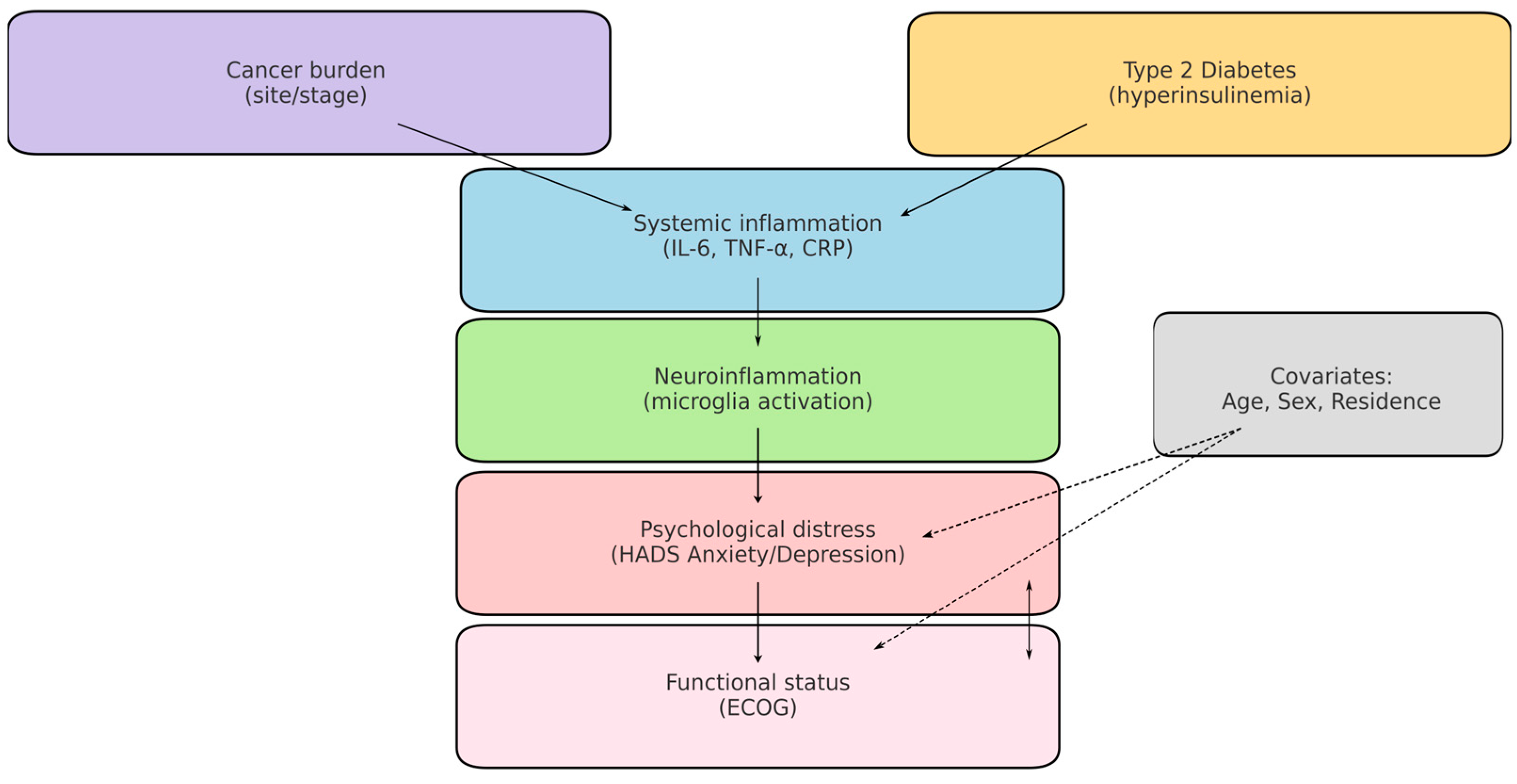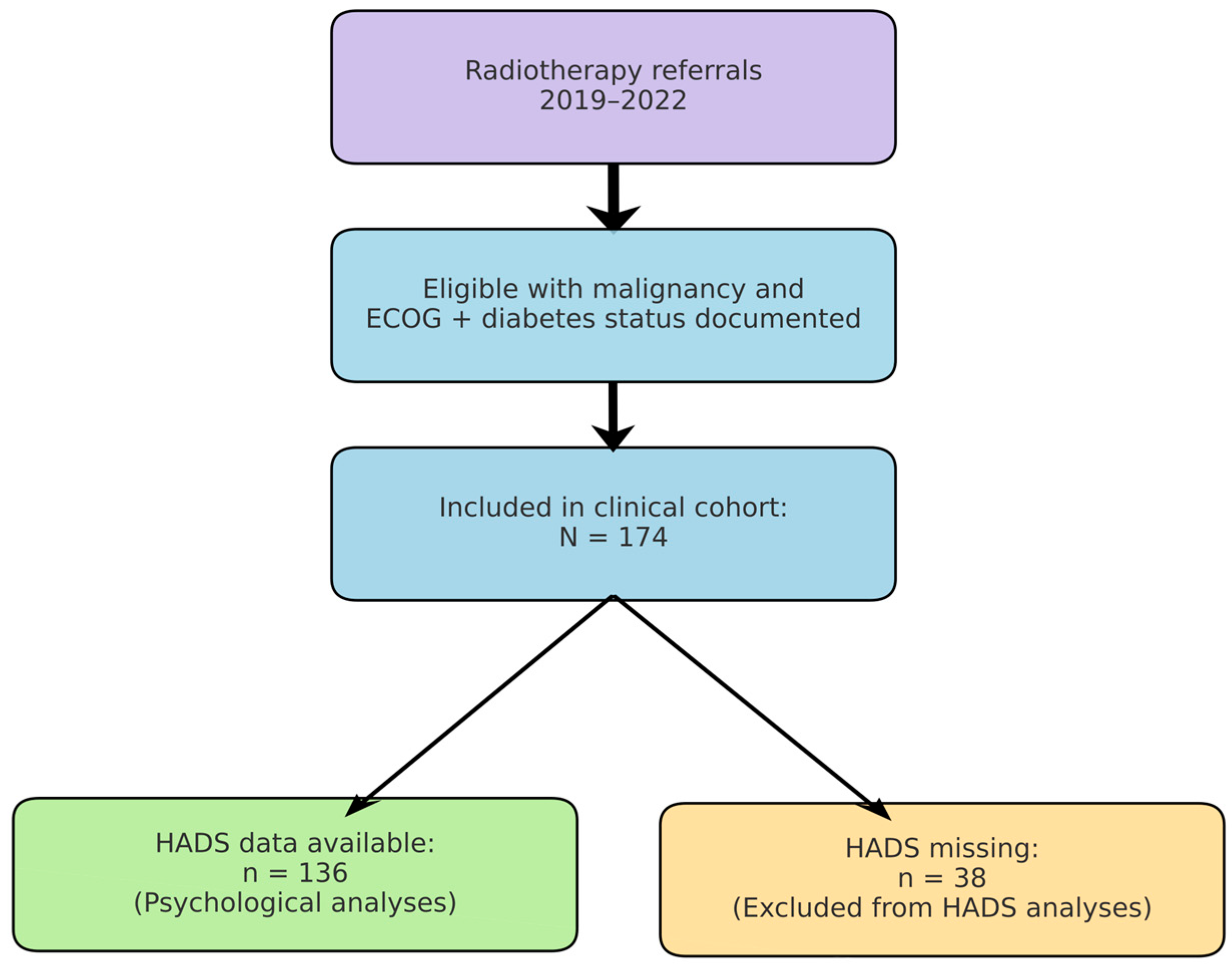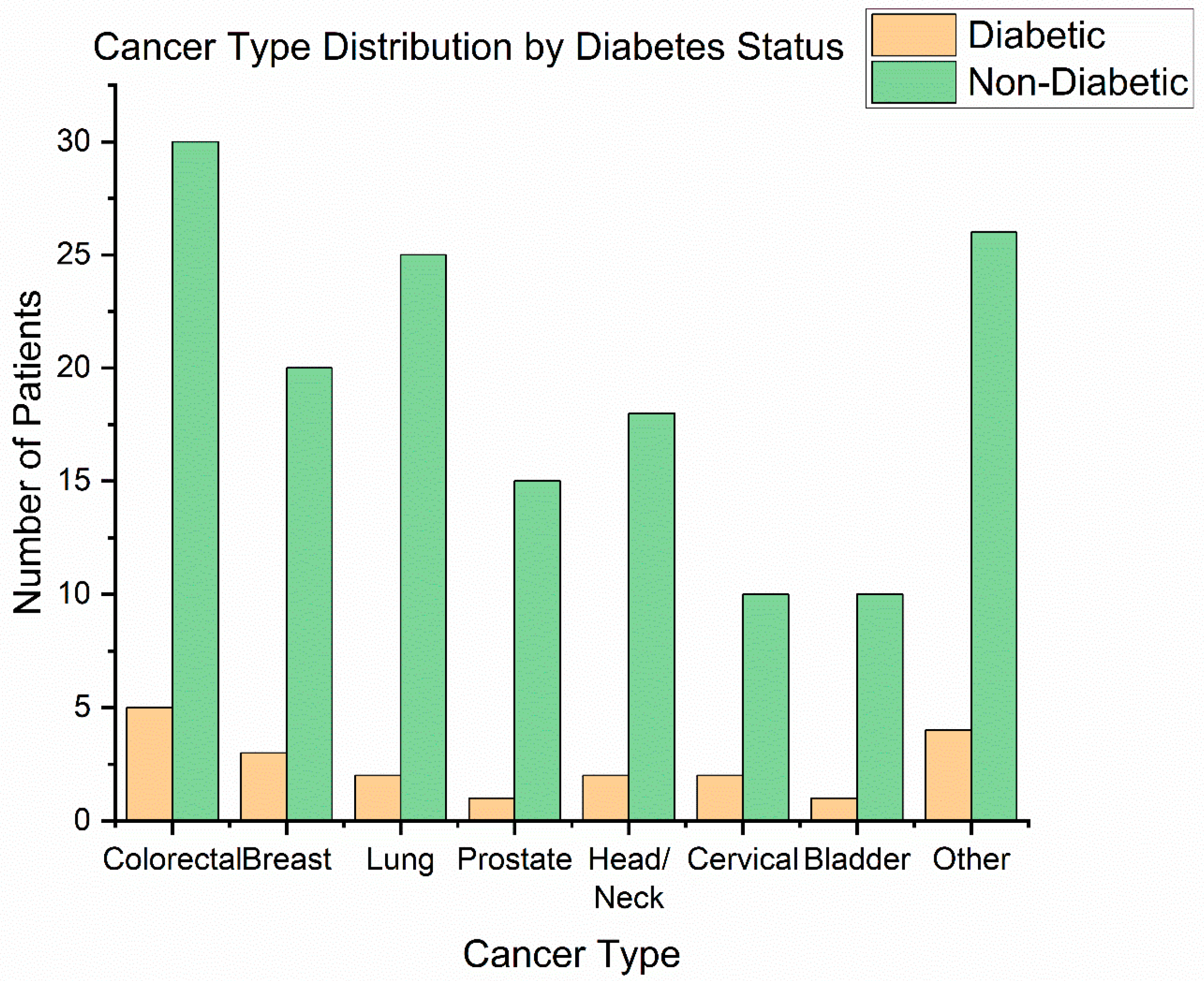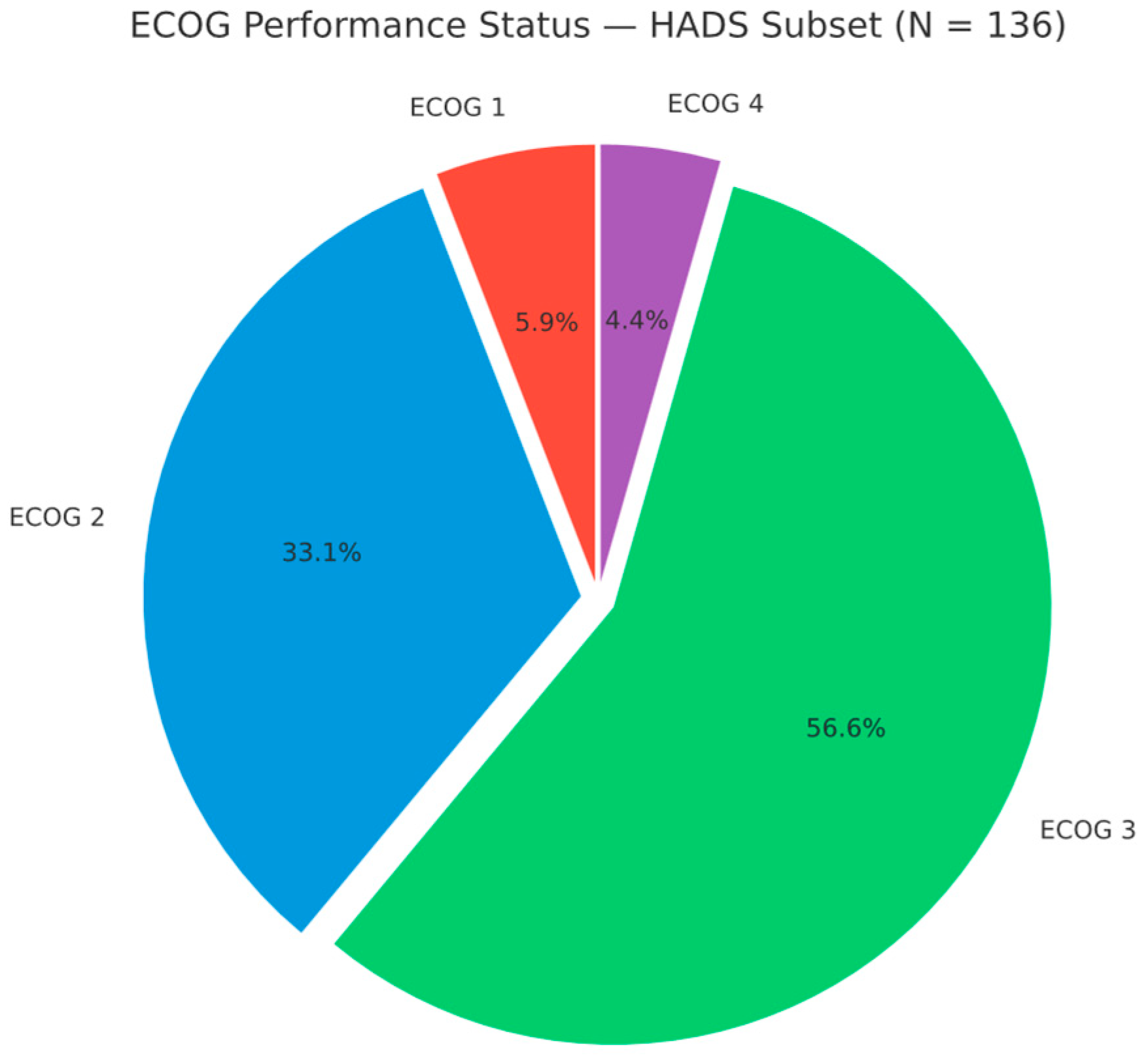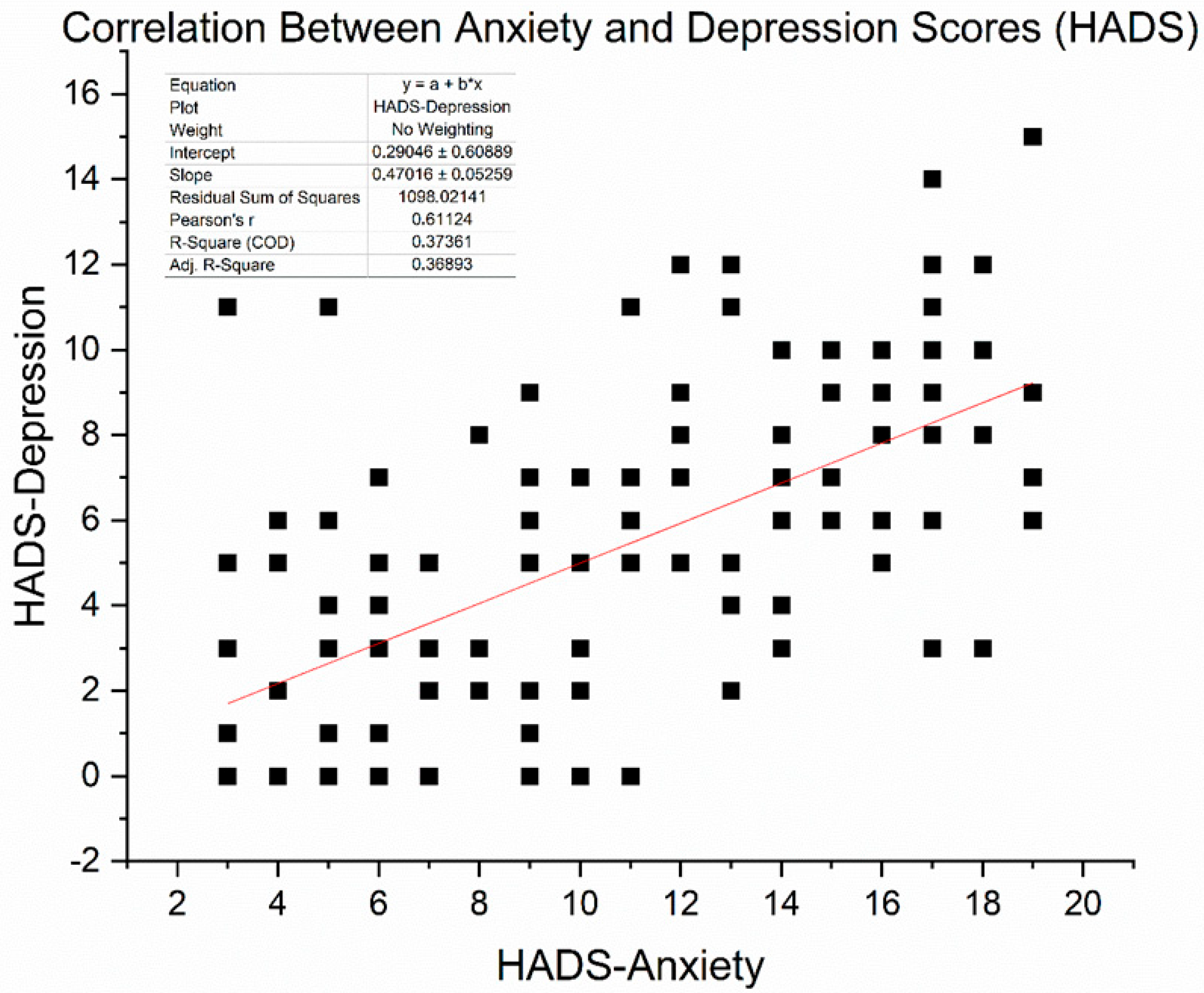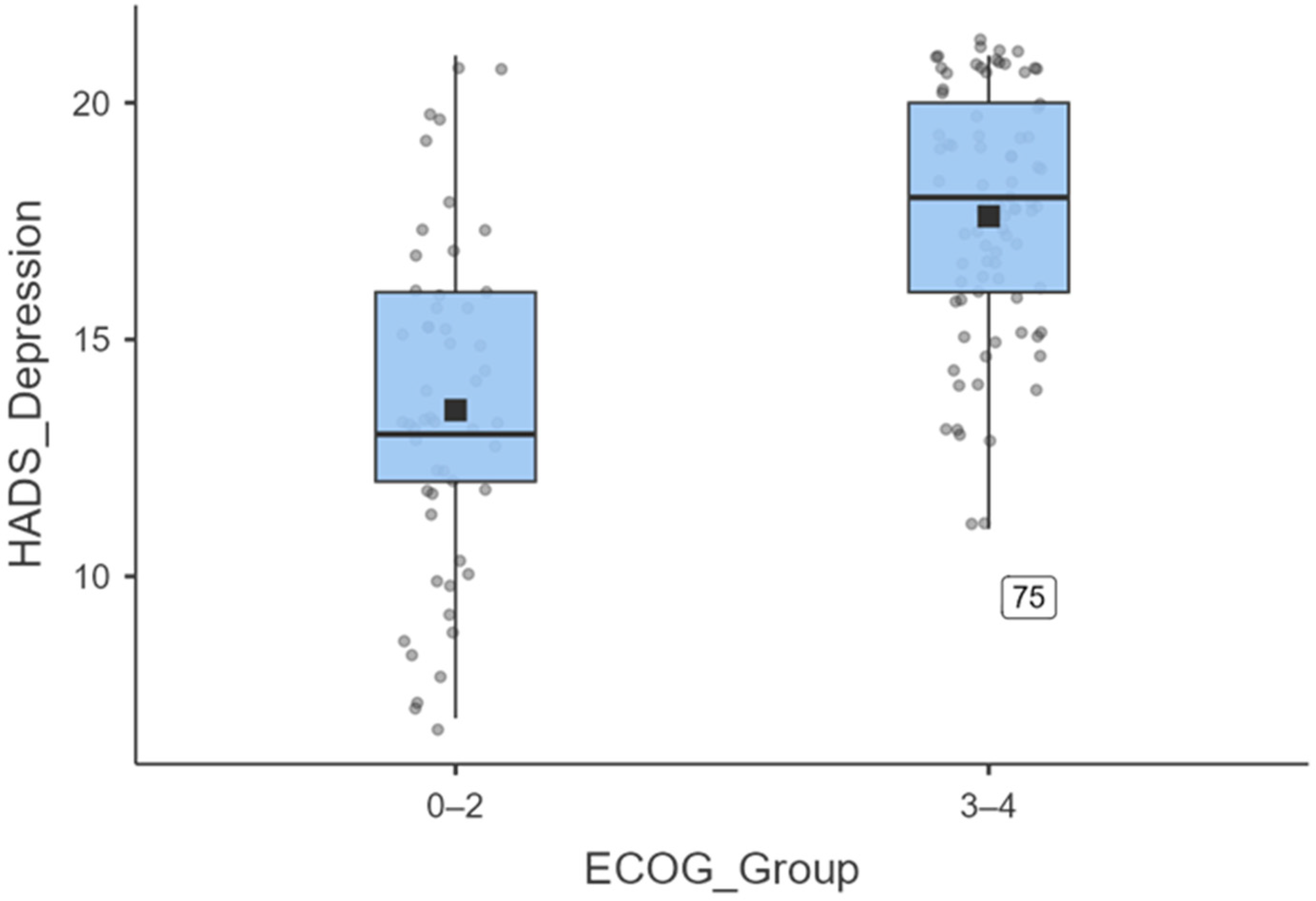4.1. Cancer-Diabetes Comorbidity and Tumour Distribution
Our cohort confirms that a substantial subset of cancer patients has coexistent type 2 diabetes mellitus (T2DM), although the 11.5% prevalence observed was lower than some international estimates. For example, a recent U.S. survey (NHANES 2017–2020) reported that 24.4% of adults with a history of cancer had T2DM [
1], while a large European cohort (EPIC) found about 7.8% with T2DM at cancer diagnosis [
30]. This variance likely reflects population differences (e.g., age, obesity rates) and the increasing prevalence of diabetes in recent years. In our Romanian sample, diabetic patients were distributed across all major tumour types with no significant association between T2DM and any specific cancer (χ
2 p = 0.54). Notably, 22% of rectal cancer patients in our series had T2DM, the highest relative co-prevalence, whereas only 4% of prostate cancer patients had diabetes [
31]. This pattern is consistent with known epidemiology: T2DM and insulin resistance are established risk factors for colorectal neoplasia [
1], whereas diabetes appears inversely associated with prostate cancer incidence. Meta-analyses indicate diabetic men have about a 9% lower risk of prostate cancer than non-diabetics, possibly due to hormonal alterations (e.g., lower testosterone or hyperinsulinemia’s growth-suppressive effects on the prostate) [
32]. Our finding of fewer diabetics among prostate cases aligns with this attenuated relationship. Similarly, the higher proportion of people with diabetes in colorectal and hepatobiliary cancers in our cohort reflects metabolic syndrome’s impact on those tumours (all four patients with diabetes and liver tumours had underlying metabolic risk factors). Although our sample size for each cancer type was limited, the overall distribution of diabetes across tumour sites in our study mirrors these broader epidemiological associations.
The co-occurrence of cancer and T2DM has important prognostic implications. Diabetes is an independent adverse prognostic factor in oncology outcomes [
33]. A landmark meta-analysis of 23 studies by Barone et al. found that pre-existing diabetes was associated with a 41% higher risk of all-cause mortality in cancer patients [
3]. More recent data continue to demonstrate this survival gap. For instance, a 2025 multinational cohort study (across 7 European countries) reported that having T2DM at cancer diagnosis confers a 25% increase in overall mortality risk (hazard ratio ~1.25) even after adjusting for other factors. Cancer-specific mortality is also modestly higher (HR ≈ 1.13) in patients with diabetes. The survival disadvantage was evident even in certain less common cancers (e.g., bladder, ovarian) in that cohort [
30]. The reasons are multifactorial: diabetes-related organ damage (cardiac, renal) may reduce tolerance to cancer therapies; chronic hyperglycaemia can impair the immune response and wound healing; and diabetes increases susceptibility to infections and treatment complications [
34]. Our study did not directly measure outcomes, but these findings underscore that cancer patients with T2DM represent a high-risk population. They often require more intensive medical management—indeed, prior research shows such patients have higher unplanned hospitalisation rates and more extended hospital stays during cancer treatment. One study noted that among cancer patients with comorbid conditions, diabetes was the leading cause of emergency department revisits (24% of unplanned returns), and diabetic cancer patients undergoing surgery (e.g., for colorectal cancer) had post-operative hospital stays ~3 days longer than non-diabetics [
1]. These real-world data highlight that the intersection of cancer and diabetes adds complexity to care and can worsen short-term and long-term outcomes. Aggressive management of glycemia and comorbid conditions is therefore essential in this group. Encouragingly, experts advise that clinicians actively optimise cardiometabolic comorbidities in cancer patients to improve survival. Our findings reinforce this need, especially in tumour types like colorectal or liver cancer, where metabolic risk modification might impact cancer prognosis as well.
4.2. Ecog Performance Status in Patients with and Without T2DM
We examined whether diabetic patients were presented with worse functional status (ECOG performance score) than their non-diabetic counterparts. Contrary to our initial hypothesis, there was no significant difference—the mean ECOG score was virtually identical (~2.5 in both groups)—and the proportion of patients with an ECOG score of ≥3 was approximately 55% in both the diabetic and non-diabetic groups. In other words, having T2DM did not correlate with worse performance status at presentation in our cohort. This finding suggests that the severity of the cancer itself was the dominant determinant of functional status, overshadowing any incremental frailty from diabetes [
35]. Many non-diabetic patients were profoundly debilitated by advanced malignancies (over half of our total sample had ECOG 3–4), which likely “levelled the playing field.” [
36]. It appears that, by the time patients required radiotherapy or oncology admission, cancer-related factors (tumour burden, cachexia, pain) drove their performance status more than chronic conditions like diabetes. Another consideration is that our diabetic subgroup, though small (n = 20), was relatively well-managed—most were on oral hypoglycaemics or diet control, and none had acute hyperglycaemic crises or uncontrolled comorbidities during treatment. Effective outpatient diabetes management might have mitigated potential functional decline. Additionally, the people with diabetes in our study were of a similar age to those without diabetes, so age was not a confounding factor for the differences in performance status.
It is worth noting that comorbidity and performance status are often interrelated in cancer patients, even if we did not observe a direct diabetes effect. Patients with multiple chronic diseases tend to have lower baseline functional reserve and may tolerate cancer treatments poorly [
30]. Prior studies have shown that comorbid conditions can lead to less aggressive cancer therapy being offered (for fear of toxicity), indirectly affecting outcomes [
37]. In our cohort, however, treatment intensity (e.g., curative chemoradiation for cervical cancer, multimodal therapy for head/neck cancer) appeared to be driven by tumour factors and patient preference rather than diabetes status—people with diabetes were not generally undertreated. Our findings align with a recent analysis, which found that a history of diabetes did not significantly alter healthcare utilisation among cancer patients when adjusting for other factors [
1]. Nonetheless, we remain cautious in interpreting the lack of ECOG difference: it may simply reflect that cancer’s impact on functional status is so severe in an oncology referral population that additional deficits from diabetes are marginal. Although our sample did not show statistically significant differences, it is plausible, based on prior reports, that larger or more diverse samples might reveal such distinctions.
We also assessed ECOG at a single time point (presentation to radiotherapy). Diabetes could still influence longitudinal functional decline or recovery trajectories. For instance, one might hypothesise that people with diabetes experience slower recovery from treatment or more fatigue over time due to metabolic issues, questions that warrant prospective follow-up. Overall, our data suggest that having T2DM should not be viewed as a barrier to aggressive cancer therapy based on performance status alone, since people with diabetes were just as likely as others to have good functional status if their cancer was not advanced. It reinforces the importance of individualised assessment; chronologic age or comorbidities alone should not prejudge a patient’s fitness for treatment, in line with geriatric oncology principles.
Importantly, the relationship between depression, T2DM, and cancer may be bidirectional. While our primary focus was on how chronic illness contributes to psychological distress, increasing evidence suggests the reverse is also true: that depression can predispose individuals to metabolic and oncologic disease via inflammatory mechanisms. Major depressive disorder is associated with HPA axis dysregulation, elevated cortisol, and altered autonomic function, all of which contribute to immune dysfunction and chronic low-grade inflammation. Increased circulating levels of IL-6, CRP, and TNF-α have been reported in depressed patients, even in the absence of overt medical illness. These mediators may impair insulin sensitivity and promote oncogenic processes, including angiogenesis and resistance to apoptosis. Thus, psychological distress may not only result from chronic disease but may also contribute to its development or progression. This underscores the importance of early psychiatric assessment—not only to enhance quality of life, but also as a potentially preventive intervention.
4.3. High Prevalence of Psychiatric Comorbidity and Influence of Diabetes
In our cohort, 58% of patients had clinically documented anxiety and/or depression, reflecting the high psychological toll of cancer. This prevalence lies at the upper end of ranges reported in the literature. Population studies generally indicate that 20–50% of cancer patients suffer from significant depression or anxiety, varying by cancer type and assessment method. For example, depression rates of 33–50% have been noted in pancreatic cancer and 22–57% in head and neck cancers—cancers known for high symptom burden—whereas some other tumours have lower reported rates [
38]. Our cohort’s 58% likely reflects several factors: we included any clinically significant distress (not only major depressive disorder), but our centre also has a proactive liaison psychiatry programme (perhaps increasing recognition/documentation of psych symptoms). A large proportion of our patients had advanced disease (which is associated with more distress). Indeed, we observed that certain subgroups—notably head/neck cancer patients facing disfigurement and cervical cancer patients who were often younger women with family and social stressors—had exceptionally high rates of anxiety/depression, consistent with trends reported in psycho-oncology studies.
These results confirm the high prevalence of psychiatric symptoms—especially depression and anxiety—in cancer patients, regardless of diabetes status. The psychological burden appears more closely related to cancer localisation and ECOG functional status than to metabolic comorbidity.
Given the high burden of psychiatric symptoms observed, our findings underscore the value of integrating early psychosocial screening into oncology workflows. This is consistent with recommendations from integrative care models and supports the need for multidisciplinary approaches in oncology practice.
When comparing psychiatric comorbidity between those with and without T2DM, we noted a numerical trend toward more frequent anxiety/depression in the diabetic subgroup (70% vs. 56.5%), but this difference was not statistically significant. The odds of having a recorded psychiatric diagnosis were about 1.8-fold higher in diabetics, but with a wide confidence interval that crossed 1. In comparison, our diabetic patients did exhibit somewhat greater psychosocial distress, but the small diabetic subsample (n = 20) limited statistical power.
Epidemiological data from general medical populations show that diabetes is strongly associated with depression, with approximately 10–12% higher prevalence of depressive symptoms compared to the non-diabetic population [
15]. This bidirectional relationship may arise from behavioural stressors related to diabetes management and the neurobiological effects of hyperglycaemia. However, in oncology, baseline distress is elevated due to the emotional impact of cancer itself, potentially masking additional effects of comorbidities like T2DM.
Our findings support this interpretation. Despite the lack of statistical significance, all diabetic patients with rectal cancer in our sample reported substantial depressive or anxious symptoms, often related to the dual burden of cancer and colostomy management atop diabetes care. In contrast, some non-diabetic rectal cancer patients coped more effectively. We also documented cases of panic attacks during radiotherapy sessions in diabetic patients, which were not observed in non-diabetics.
We anecdotally observed that diabetic patients, particularly those with rectal cancer, often experienced more intense psychological distress, including panic episodes. Although these patterns did not reach statistical significance, they align with qualitative literature suggesting that cancer patients with diabetes may face heightened psychological burden, especially when treatment complexity intersects with diabetes self-management. This trend may reflect both behavioural stress and physiological vulnerability, as discussed in psycho-oncology literature.
This is consistent with previous reports showing worse quality of life in cancer patients with comorbid diabetes, particularly if their glycaemic control is suboptimal during treatment [
39]. For example, Kern et al. documented heightened anxiety and frustration in diabetic breast cancer survivors who had to manage blood sugars during chemotherapy [
39,
40]. Our findings underscore the importance of tailored psychosocial interventions in oncology, particularly for patients facing multiple health-related challenges. While T2DM did not statistically increase the incidence of psychiatric symptoms in our sample, these patients may still warrant extra attention.
4.4. Psychological Distress Severity (Hads Scores) and Correlation with Ecog
To quantify psychological symptoms, we analysed Hospital Anxiety and Depression Scale (HADS) questionnaires from a subset of 136 patients. The results painted a sobering picture: overall, the mean scores for both anxiety and depression subscales were around 15–16 (out of 21), significantly above the usual clinical cut-off of 11. Indeed, over 80% of patients who completed HADS met the criteria for at least moderate anxiety or depression. These figures confirm that most of our patients were experiencing clinically significant distress, supporting the high prevalence noted in chart diagnoses. When stratified by diabetes status, there were no significant differences in mean HADS scores—in fact, diabetic patients had slightly lower average anxiety scores (14.8 vs. 16.1), with similar depression scores compared to non-diabetics. This somewhat counterintuitive finding (one might expect people with diabetes to have higher distress) can be explained by a few considerations. First, as discussed, cancer-related distress was already widespread in both groups, potentially overshadowing any modest increase due to diabetes. Second, diabetic patients were on average slightly older (though not significantly), and we observed anecdotally that older patients tended to report slightly less anxiety, possibly due to better emotional coping or acceptance, or different response styles (younger patients sometimes had more overt anxiety about family and the future). Third, some diabetic patients might have already been receiving psychiatric treatment (e.g., SSRIs or anxiolytics) before or during cancer care, which could have reduced their reported anxiety levels. Regardless, the absence of a diabetes effect on HADS reinforces our earlier point: the presence of cancer created a uniformly high distress environment, so having T2DM did not significantly worsen self-reported mood symptoms. This aligns with the non-significant difference in diagnosed psychiatric comorbidity rates. It also echoes findings from a supplementary analysis we conducted using HADS cut-offs: the proportions of patients with HADS-Anxiety scores ≥ 11 was 75% (diabetic) versus 82% (non-diabetic), p = 0.49, and for HADS-Depression scores ≥ 11, it was 75% versus 86%, p = 0.28. Thus, distress was widespread in both groups, and diabetes was not a key factor in our quantitative mental health assessment.
One of the most salient findings in our study was the relationship between performance status and psychological distress. We found a moderate, statistically significant positive correlation between ECOG score and HADS total score (Spearman ρ = 0.414,
p < 0.001), indicating that patients with worse functional status (higher ECOG) tended to report higher levels of combined anxiety/depression [
41]. In practical terms, those who were more debilitated by their cancer also felt more psychologically distressed. This correlation is intuitive and supported by wider literature [
20,
42]. Advanced disease often brings greater symptom burden (pain, fatigue, disability), which can precipitate depression and anxiety. Conversely, patients who are very depressed may be less active or perceive their functional status as lower. Our objective ECOG assessments align with the notion that physical and psychological well-being decline in tandem. In our data, the mean HADS scores were lowest in the few patients with an ECOG score of 1 and progressively higher in those with ECOG scores of 2, 3, and 4. For instance, mean HADS-Depression was ~13.6 at ECOG 1 and ~17–19 at ECOG 3–4, indicating a marked increase in depressive symptoms in those with significant functional impairment. This trend remained evident even when we dichotomised: patients with “good” performance (ECOG 0–2) were much more likely to have normal HADS scores, whereas those with ECOG 3–4 almost universally had abnormal (elevated) HADS scores. A recent study of advanced lung cancer patients similarly reported that those with ECOG 3–4 and inpatients/palliative care settings had very high anxiety and depression levels, whereas patients with ECOG 0–1 or on outpatient treatment had significantly lower distress. The authors noted that hopelessness and loss of autonomy in those with poor performance status contributed to psychological suffering [
43]. Our findings are consonant with this: for many patients, declining functional status likely means loss of independence, increased pain/fatigue, and a sense of approaching end-of-life—all of which fuel depression and anxiety. From a biological perspective, this link may also be mediated by disease severity: patients with worse ECOG often have more aggressive or widespread cancer, which is frequently accompanied by higher levels of inflammatory cytokines (e.g., IL-6, TNF-α) and paraneoplastic symptoms that can induce “sickness behaviour” (lethargy, low mood) [
44]. Clinical vigilance is therefore required—patients with poor ECOG should be routinely screened and treated for depression/anxiety, as addressing their mental health needs is integral to palliation. Conversely, helping to manage distress (through counselling, medications, physical therapy for symptom control, etc.) might in turn improve patients’ functional ability or at least their perception of it. Our study underscores the importance of this mind–body interplay: treating the whole patient is crucial, as psychological and physical states are deeply interconnected [
43,
45,
46].
4.6. Neuroinflammatory Links Between Cancer, Diabetes, and Depression
Although our study did not include direct measurements of inflammatory biomarkers, the observed clinical patterns are discussed here within a theoretical framework of neuroinflammation. This model is supported by converging evidence from prior literature, suggesting that chronic low-grade inflammation plays a central role in the pathogenesis of cancer, diabetes, and depression. These data reinforce
A growing body of evidence indicates that chronic low-grade inflammation is a common denominator in T2DM and major depressive disorder. Patients with either condition alone show elevated circulating proinflammatory cytokines such as interleukin-6 (IL-6) and tumour necrosis factor-alpha (TNF-α), among others. In diabetes, adipose tissue inflammation and high serum IL-6/TNF levels are well-documented, contributing to insulin resistance and also potentially affecting the brain and behaviour [
15]. Cancer, especially advanced cancer, further amplifies this inflammatory milieu: tumours secrete cytokines (such as IL-1β, IL-6, and TNF-α) as part of immune evasion and tumour progression processes. These cytokines can cross the blood–brain barrier or activate vagal and microglial pathways, inducing central inflammatory responses that manifest as depressive symptoms (the so-called “sickness behaviour” syndrome). Notably, IL-6 has been implicated as a key mediator of cancer-related depression. For example, Lutgendorf et al. demonstrated in ovarian cancer patients that elevated IL-6 (in both plasma and even tumour ascites) correlated specifically with vegetative depressive symptoms like fatigue and anorexia [
51,
52]. Similarly, a 2022 meta-analysis by McFarland et al. found that among cancer patients, those with higher peripheral IL-6 and TNF-α levels had significantly worse depression scores (pooled effect sizes ~0.6–0.7). These data reinforce that inflammation is not just an epiphenomenon but a driving factor in depressive symptoms in oncology [
53].
It is essential to emphasise that these insights are based on previous research, rather than being directly evaluated in our cohort. Therefore, the neuroinflammatory model we propose remains a conceptual framework for understanding the high levels of distress observed in this medically complex population.
In our study, while we did not measure cytokines, the clinical outcomes align with an inflammatory model. The fact that virtually all our patients—diabetic or not—had elevated distress suggests a common biological stressor, likely the cancer itself, with its inflammatory burden. Adding diabetes on top might raise inflammation further, but in an already high-inflammation environment (advanced cancer), the incremental effect may be small or hard to discern clinically [
54]. It is plausible that both our diabetic and non-diabetic cancer patients had high IL-6/TNF due to cancer; the people with diabetes might have had slightly higher levels, but all above a threshold that predisposes to depression [
55,
56]. This could explain why we did not see significant mood differences by diabetes status: both groups had cytokine-driven depression to a similar degree. That said, one might speculate that specific inflammatory markers (like C-reactive protein or IL-6) were even more elevated in the diabetic subgroup, potentially contributing to the trend toward higher psychiatric morbidity. This is an area for future investigation—profiling inflammatory biomarkers in cancer patients with vs. without T2DM could elucidate whether the “double inflammation” of cancer + diabetes translates to greater neuroimmune activation. If so, it raises the question of therapeutic targeting. There is growing interest in using anti-inflammatory strategies to treat depression, especially in those with elevated inflammatory markers. Small trials of cytokine inhibitors (e.g., anti-TNF agents or IL-6 blockers) in treatment-resistant depression have shown modest benefits. In cancer patients, the use of anti-cytokine therapies (like tocilizumab for cancer-related cachexia or depression) is still experimental, but conceptually promising. Likewise, integrative interventions such as exercise and diet, which reduce systemic inflammation, could have dual benefits for glycaemic control and mood. Recent data also indicate that unhealthy behaviours—notably higher alcohol intake—are linked to heightened anxiety, depression and impulsivity even in otherwise healthy young adults, underscoring alcohol reduction as an additional modifiable target in neuroinflammation-driven mood disorders [
57]. Our study’s context—a Special Issue on neuroinflammation in psychiatric conditions—underscores that tackling inflammation might be a unifying approach to improve outcomes in patients burdened with both medical and psychiatric illness. In summary, the interplay of cancer, diabetes, and depression can be viewed as a vicious cycle mediated in part by inflammatory cytokines and stress hormones. Breaking this cycle will likely require interventions that address both the biological underpinnings (inflammation, HPA axis dysregulation) and the psychosocial stressors [
15,
58].
In cancer patients, this inflammatory environment is often worsened by tumour-derived cytokines and treatment-related stressors. Notably, IL-6 has become a potential biomarker for cancer-related depression, especially in patients with advanced or treatment-resistant disease. Recent studies showed that baseline CRP and IL-6 levels predicted depressive symptoms during chemotherapy in a prospective cohort of lung cancer patients. These findings support the idea that neuroinflammation may be a shared underlying cause, possibly explaining the high rates of anxiety and depression seen in oncologic patients with metabolic comorbidities [
51,
59,
60,
61]. Our data supports this idea, although we did not directly test it.
4.7. Clinical and Public Health Implications: Toward Multidisciplinary Care
Our findings carry several clinical and public health implications. They highlight the need for a genuinely multidisciplinary approach in managing patients who stand at the crossroads of oncology, endocrinology, and psychiatry. First, from a clinical practice standpoint, the data support current guidelines that recommend integrated psychosocial and medical care in oncology. The American Society of Clinical Oncology (ASCO) and other bodies recommend routine distress screening for cancer patients and timely intervention (e.g., psycho-oncology referrals, counselling) as part of standard care. Our observation that over half of patients have significant anxiety/depression, and virtually all patients with poor performance status do, means that oncologists and nurses must be vigilant in assessing mental health at each stage. Embedding mental health professionals in oncology clinics or establishing referral pathways can ensure issues are addressed early. There is evidence that doing so improves outcomes: psychological interventions (such as cognitive-behavioural therapy, relaxation training, etc.) significantly enhance quality of life for cancer patients and can reduce distress levels by moderate effect sizes. While these interventions may not extend survival in early-stage cancers, they undeniably improve patients’ day-to-day well-being and emotional functioning, outcomes that are valuable in their own right and may aid patients in adhering to treatment plans [
62,
63].
Second, our study underscores the importance of co-managing metabolic comorbidities like diabetes during cancer treatment. In busy oncology practices, it is easy to focus narrowly on cancer and inadvertently neglect other chronic conditions. However, our findings and the literature suggest this would be a mistake: uncontrolled diabetes can lead to treatment interruptions (e.g., from infections or severe fatigue) and may worsen cancer prognosis [
1]. Multidisciplinary case conferences, also known as “tumour boards,” should ideally include consideration of comorbid conditions—for example, involving an endocrinologist or internist when formulating a treatment plan for a patient with active diabetes. Some cancer centres have begun to develop “oncodiabetology” services, recognising the need for endocrinology input in patients receiving corticosteroids or other treatments that disrupt glucose control [
64]. A recent national study highlighted that cancer patients often receive fragmented care: during active treatment, visits to primary care providers drop, and oncologists may not manage diabetes actively [
39]. Interventions are needed to bridge this gap, whether through the co-location of services, telemedicine follow-ups for diabetes management, or clear protocols for comorbidity management. From a policy perspective, improving care coordination is paramount. Jo et al. found that patients with cancer and prediabetes had significantly higher healthcare utilisation (more visits) than those with cancer alone, suggesting that identifying and managing early deglycation could reduce downstream complications. They concluded that optimal care coordination and early metabolic risk management may improve cancer survivorship and reduce healthcare burden [
1]. This supports initiatives to integrate primary care and oncology for survivorship, as well as during acute cancer care.
Third, our results have implications for resource allocation and survivor follow-up. As more patients survive longer with cancer, the convergence of cancer, diabetes, and depression will become increasingly prevalent. This triple comorbidity can be viewed as a “syndemic”—diseases that act synergistically to worsen overall patient health. Public health programmes should consider screening cancer survivors for metabolic syndrome and mental health problems as part of routine survivorship care. For example, a survivorship clinic visit might include HbA1c testing and a depression screen (HADS or PHQ-9), with referrals made accordingly. On the flip side, diabetologists should be aware that their patients have an elevated risk of certain cancers and depression and ensure appropriate cancer screenings and mental health evaluations are performed [
12,
65]. The need for integrative care models is evident. Multidisciplinary clinics or at least multi-speciality collaboration can yield better outcomes. In our local context, we found value in having a liaison psychiatrist and a nutrition/metabolic specialist as part of the oncology team. These inputs helped tailor interventions (like prescribing appetite stimulants or anxiolytics, adjusting diabetic diets during treatment) that improved patients’ tolerance of therapy. Patients themselves appreciate this approach: qualitative research reports that cancer patients with comorbid diabetes desire a designated provider or team to help coordinate their dual care, along with better education on how to manage diabetes during chemotherapy [
65]. In Kern et al.’s study, participants suggested having a single care plan that addresses both illnesses, rather than siloed advice from oncologists and primary care [
39,
66]. This kind of patient-centred integration could reduce confusion and anxiety, thereby improving self-management. Our findings echo that sentiment—the more we treat the patient holistically, the better the likely outcomes in all domains.
The synergistic relationship between physical comorbidities and psychological distress in oncology demands an integrative management strategy. Cancer care must evolve from a single-disease model to a comprehensive model that accounts for metabolic health and mental health. Practically, this could involve routine distress thermometer screenings, endocrinology consults for hyperglycaemia management, physical rehabilitation to maintain function, and anti-inflammatory lifestyle interventions—all alongside standard oncologic treatment. Such multidisciplinary care not only addresses current needs but may also confer long-term benefits, as improved metabolic and mental health could potentially translate into better cancer survival [
30]. Notably, our study provides evidence from an Eastern European population, a group underrepresented in the psycho-oncology literature, reinforcing that these issues transcend geographic and healthcare system differences. The challenge ahead lies in implementation—aligning specialists, training oncology providers in basic diabetes/psychiatric care (and vice versa for primary care providers in cancer survivorship), and ensuring patients do not “fall through the cracks” between specialities. The public health stake is high: with millions of cancer survivors worldwide, many of whom carry comorbid conditions, investing in integrative care models is investing in improved quality of life and outcomes for a growing segment of our population.
Our findings support the idea that psychological distress is widespread among cancer patients, regardless of diabetes status, but the additional challenge of managing coexisting T2DM may require more careful attention. Interventions that target IL-6, oxidative stress, or microglial activation could serve as promising translational strategies to reduce both psychiatric symptoms and systemic disease progression. Future research should explore biomarkers of neuroinflammation (e.g., CRP, IL-6, kynurenine pathway metabolites) to better define risk profiles and tailor supportive care.
This study has several limitations. First, the diabetic subgroup was small (n = 20), which limits statistical power and precludes strong conclusions about diabetes-specific effects. Second, HADS data were available only for 136 of the 174 patients, which may introduce selection bias. Patients without psychological assessments may differ systematically from those included in the analysis, for example, in terms of clinical severity or timing of evaluation. Third, the single-centre design and inclusion of patients with advanced-stage cancers limit the generalizability of the results. Furthermore, neuroinflammation was discussed as a theoretical framework but was not directly assessed in this study.
Additionally, due to the specific profile of the radiotherapy centre, there was an overrepresentation of pelvic and head and neck cancers, while certain tumour types (e.g., hematologic or early-stage breast cancers) were underrepresented, further limiting the generalizability of findings to the broader cancer population.
Beyond the cross-sectional design, multivariable analyses were limited by the small number of T2DM cases and incomplete tumour-site data, which widened confidence intervals and increased the risk of a type-II error. Although robust errors and sensitivity assessments were conducted, residual confounding cannot be ruled out. Logistic modelling of psychiatric comorbidity (HADS ≥ 11) was constrained by quasi-separation due to high prevalence.
Although our findings showed a slightly higher percentage of psychiatric diagnoses in patients with T2DM, HADS scores did not differ significantly between groups. This indicates that the distress burden was primarily driven by the cancer diagnosis itself, rather than by metabolic status. As such, we emphasise that these differences are descriptive rather than inferential.
